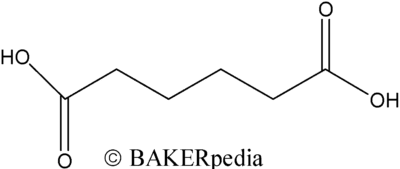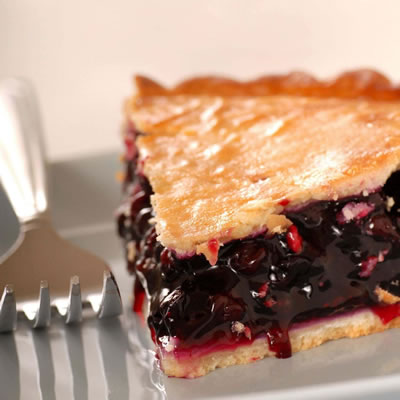Adipic Acid
What is Adipic Acid?
Adipic acid is a dicarboxylic acid with the lowest acidity of commonly used food acids. It is a food additive which serves several functions in jams, beverages and baked goods. It’s used as an acidulant, pH regulator, flavoring, buffering and leavening agent.¹,²
In baking, this acid is typically used as:¹,²
- Leavening agent with baking soda
- Substitute for cream of tartar and ascorbic acid
- Texture firmer
Chemical Structure

Origin
Natural sources of adipic acid include beet and sugar cane, pork fat, guava fruit, papaya and raspberry which are economically feasible. Commercially-available adipic acid crystalline powder is obtained via a synthetic process which was developed in 1906 for industrial applications and is still used today.³
Regulatory approval for using this acid in foods was granted in 1965.
Function
Adipic acid serves several functions in baked goods:¹,²
- Leavening acidulant along with baking powder
- pH regulator mainly in confections, jellies and jams
- Buffering agent mainly for systems in the pH 2.5-3.0 range
- Unique flavor enhancement and desirable smooth tartness
- Sequestrant in edible oil and fats
- Whipping ability enhancer in egg whites
- Gelling aid in gelatin-based desserts
- Ascorbic acid and cream of tartar substitute with improved results
Nutrition
Adipic acid is safe for consumption under the set conditional daily intake of 0 – 5 mg/kg of body weight.
Commercial production
Adipic acid is produced commercially by the following process: ¹,²
- Oxidation of cyclohexane in the presence of air to form a mixture of cyclohexanone and cyclohexanol.
- Oxidation of the cyclohexanone and cyclohexanol mixture with nitric acid to produce the adipic acid.
The process has a theoretical yield of 92-96% when high purity cyclohexanone and cyclohexanol mixture is used.¹,²
Application
Adipic acid is used in a variety of ways in baked goods. Most commonly, in chemically leavened bakery products as a leavening agent, and in pie filling as gelling aid and buffering agent.¹,²
It can substitute for tartaric acid and cream of tartar, due to its non-hygroscopicity.¹,² It has a neutralization value (NV) of 115, implying that 115 grams of bicarbonate are required to neutralize 100 grams of adipic acid.
The following table summarizes usage limit and impact of this acid on some food systems:¹,²
| Food System | Limit | Effect |
| Baked goods | 0.05% |
|
| Dairy products | 0.45% |
|
| Fats and oil | 0.3% |
|
| Frozen dairy desserts | 0.0004% |
|
| Gelatin and puddings | 0.1% |
|
Regulations
This acid is considered GRAS by the FDA, when used for its intended purpose following good manufacturing practices.4,5
In the EU, this acid (E 355) is recognized as safe and it’s regulated by the EC Regulation 231/12/EC.4,5
References
- Burdock, G.A. Encyclopedia of food and color additives. Vol. 1. CRC press, 1997, pp. 49-52.
- Tu, A. T, and J. A Maga. Food Additive Toxicology. Marcel Dekker, 1995, pp. 45-48.
- “Adipic Acid – American Chemical Society”. American Chemical Society, 2020, https://www.acs.org/content/acs/en/molecule-of-the-week/archive/a/adipic-acid.html . Accessed 6 Sept 2020.
- Food and Drug Administration (FDA). US Department of Health and Human Services. CFR Code of Federal Regulations Title 21, Part 184 Direct Food Substances Affirmed as Generally Recognized as Safe, https://www.accessdata.fda.gov/scripts/cdrh/cfdocs/cfcfr/CFRSearch.cfm?fr=184.1009 , Accessed 06 September 2020.
- European Commission (EC). COMMISSION REGULATION (EU) No 231/2012 of 9 March 2012 laying down specifications for food additives listed in Annexes II and III to Regulation (EC) No 1333/2008 of the European Parliament and of the Council . Official Journal of European Communities, 09 March 2012.


